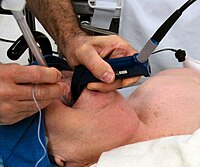
Photo from wikipedia
Background Successful airway management is a fundamental part of cardiac and respiratory arrest care. Since our last airway management record review in 2010, the supraglottic airway (SGA) has replaced endotracheal… Click to show full abstract
Background Successful airway management is a fundamental part of cardiac and respiratory arrest care. Since our last airway management record review in 2010, the supraglottic airway (SGA) has replaced endotracheal intubation (ETI) as the primary advanced airway intervention, and the i-Gel has become the SGA device of choice. This re-audit aimed to assess for improvements since 2010 and ensure all aspects of essential and advanced airway management are being carried out effectively. Methods A retrospective review of 384 cardiac and respiratory arrest clinical records were assessed against standards of care derived from national and local ambulance service guidance. Results Improvement was evidenced in the following areas: clearance of the patient’s airway (+14%; 100%, n=237/237); use of simple manoeuvres (+11%; 99%, n=377/382), and documentation of high flow oxygen (+12%; 88%, n=336/381). There was a reduction in the documented use of simple adjuncts (-2%; 86%, n=320/373). An advanced airway was attempted for 100% (n=325/325) of patients clinically indicated to receive one and was successful for 98% (n=317/325). An SGA was attempted for 100% (n=290/290) of clinically indicated patients, and an ETI for 98% (n=116/118). EtCO2 values were recorded for 98% (n=309/317) of patients, and 79% (n=249/317) had a capnograph printout submitted showing a box wave-form. Conclusions Findings indicate improvements since 2010 in many areas of essential airway management, and that advanced airways were frequently successfully placed, with the SGA the most commonly used method. However, further improvement is required in the documentation of the administration of high flow oxygen, the use of simple adjuncts, and the submission of capnography printouts. To ensure a focus on these areas, amendments have been proposed to the Trust’s continual audit process which allows for individualised feedback tailored to each clinician.
Journal Title: Emergency Medicine Journal
Year Published: 2022
Link to full text (if available)
Share on Social Media: Sign Up to like & get
recommendations!